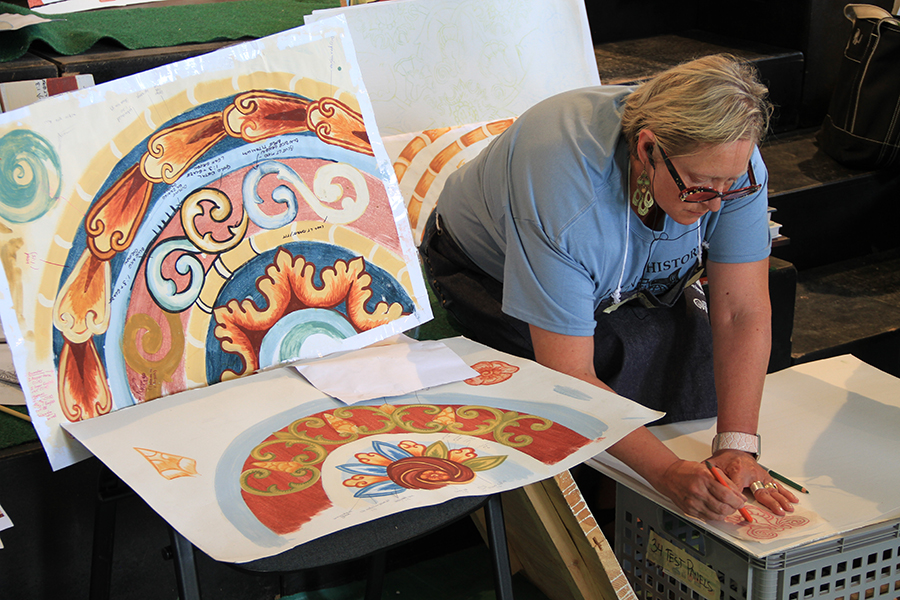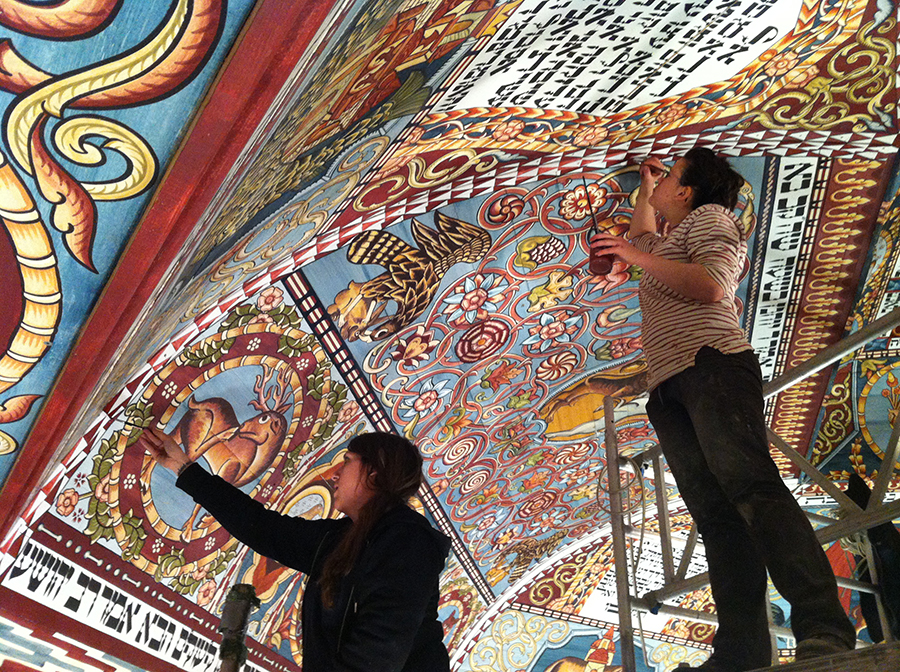Replicating the Gwozdziec Wooden Synagogue /
Gwozdziec Synagogue, drawing by Karol Maszkowski, 1893.
In the 17th and 18th centuries a historically unique type of synagogue emerged in the Polish Lithuanian Commonwealth. The wooden synagogue was an exquisite expression in timber and paint of Poland’s historical diversity. The Gwozdziec Synagogue was a magnificent example. In 1731 the prayer hall ceiling was transformed from a low barrel vault into a towering, tent-like cupola and every surface was painted in vibrant colors. Nearly two hundred of these wooden synagogues had been destroyed by the end of the Nazi invasion of Poland in World War II.
Watch Raise the Roof on Amazon
or arrange a screening here.
Summer 2011 and Summer 2012
During summers of 2011 and 2012, Handshouse Studio and the Association of the Jewish Historical Institute collaborated to replicate the 17th century Gwozdziec Synagogue roof and painted ceiling, to be the centerpiece of the Core Exhibition of Museum of the History of Polish Jews in Warsaw, Poland and become a window into a past that was nearly lost. The Gwozdziec Reconstruction Making/History: The Wooden Synagogue Replication Project has been a once-in-a-lifetime opportunity for students from many disciplines to work in 12 workshops located in 8 cities throughout Poland involving 58 professionals and 238 students from 26 American and 12 Polish universities. Using the Handshouse Studio educational model of ‘learn by doing’ and working shoulder to shoulder with an international team of professionals, they rebuilt this extraordinary example of Jewish/Polish art and architectural history. Students can make history!
Timber Frame Workshop
Handshouse Studio partnered with the Timber Framers Guild, a non-profit educational membership association dedicated to the craft of timber framing, to organize an international workshop to recreate the Gwozdziec synagogue timber frame roof structure in Sanok, home of Poland’s largest open-air Ethnographic Architectural Museum.
Using period tools—only axes and a traditional pit saw—students, worked along side professionals in an unprecedented effort in recent times, converted over two hundred logs into dimensional timbers. Twenty-five professional timber framers led by 7 team leaders, trained and apprenticed nearly sixty students through all stages of the log wall timber frame joinery, roof truss and the unique curved panel installation sequence. The painted ceiling panels were fitted into the roof structure and were prepared for the 8 painting workshops that followed. In six weeks—through this international educational cooperation—the Gwozdziec synagogue timber roof structure is now a one of a kind “hand-made” recovery of history.
…I can guarantee that we will all be going home with more muscles than we came with, and I have been ceaselessly impressed by everyone’s grit and determination, and sheer hard work, and I for one am already missing that sweet, sweet sound of a freshly sharpened saw, swooshing its way along the snap line! —Barbara Czoch, Timber Framer
Read more about the workshop in Sanok in Timber Framing and in the Gwozdziec Timber Frame Guild Blog
I can’t get away from the political and cultural significance of these efforts, particularly because I’m an Ashkenazi Jew and this is much of the reason I decided to participate. I had never seen a 17th century wooden synagogue and was unaware of the sophistication and beauty of these structures. This project introduced me to an exciting example of Jewish cultural heritage that has remained underappreciated for centuries, one that I may otherwise never have encountered. People came from around the world with a variety of backgrounds, skills, and interests, in order to contribute to the Gwozdziec Rekonstrukcja undertaking. Everyone ate, drank, worked, and played (soccer) together, creating a special kind of community. Disparate (joints) individuals held together by a common (peg) purpose. The work required constant awareness of the body and its surroundings and often involved a group effort. Much of the beauty of the experience came from these human-to-human interactions, our unique commonality and indescribable bond. —Alison Kruvaunt, Oberlin College
Ceiling Painting Workshops
Jan 21, 2021
In Honor of Maria and Kazimierz Piechotka
With heavy hearts, Rick and I, and Handshouse Studio wish to honor the lives of Maria and Kazimierz Piechotka. Maria Piechotka recently passed on Nov 28, 2020 and her husband Kazimierz passed in 2010. The Handshouse Studio’s Gwozdziec Synagogue reconstruction for the POLIN Museum of the History of Polish Jews was possible because of their work and research.
Handshouse Studio and the Association of the Jewish Historical Institute of Poland and Museum of the History of Polish Jews coordinated with seven communities throughout Poland to use existing masonry synagogues as locations for the Gwozdziec ceiling painting workshops. Over 90 professional artists and students participated in all aspects of the painting: reviewing the archival documentation of the original Gwozdziec ceiling, preparing the panels with traditional gesso, tracing the images onto the panels and finally painting them with traditional distemper paints made of pigments and rabbit skin glue.
Colors were made from minerals and indigo woad, a traditional blue pigment made from the dried and crushed woad plant, and bice, another blue pigment made from copper oxide. All painting was done on boards that are sealed with a traditional caulk and glue gesso. During the painting workshops every participant learned how make and apply gesso to the boards and to mix and grind the pigments with glass mullers, using the specific formulas for the various colors. Watch the Meditative Art of Mixing Paint. Each participant was required to make a full-scale test panel of a part of the ceiling painting, carefully executed and documented and approved before anything was allowed on the finished boards. All choices were made after careful scrutiny of archival information, fieldwork documentation, and the general consensus of the core painting team.
Read and see more from our painting crew: Gwozdziec Painting Blog
I have always been an athlete…Last summer (The Kazimierz Dolny Painting Workshop) really allowed me to explore my artistic interests. I was in charge of painting the flames on the east wall and let me tell you, this was harder than anything I had ever done before in sports. I had no idea the amount of concentration you needed to have when painting. Not only that, but you also needed a steady hand, proper brush strokes, and a good eye for detail. I had such trouble in the beginning that I almost thought about giving up on the flames. I was embarrassed and felt extremely awkward. I had never faced anything that did not come easy to me or that I had much trouble with. While the painting came easy to most of the other students on the trip, I was having a very difficult time. With this said, I knew I had to stick it out and give it my best. With much practice on test panels and coaching from some painting leaders (Nick), I succeeded in painting the flames to the best of my abilities. —Jordan Pardo, Brandeis University
The painted ceiling workshops took place in 8 consecutive three–week sessions in 8 cities throughout Poland in existing masonry synagogues. See Workshop Details. The workshops were lead by 12 artist painting leaders, who worked with students and volunteers over two summers to paint the 14 sections of the polychrome ceiling: the lantern, the zodiac, north dome, south dome, east dome, west dome, northeast pendentive, northwest pendentive, southwest pendentive, southeast pendentive, and north, south, east, and west coves. The workshops were welcomed by the communities of the White Stork Synagogue in Wrocław, the New Synagogue in Rzeszów, the Temple Synagogue in Krakow, the White Synagogue in Sejny, the New Synagogue in Gdansk, the Synagogue of Kazimierz Dolny and the Synagogue of Szczebrzeszyn. The workshops served as teaching platforms not only for students creating the paintings, but also to engage members of the communities through demonstrations, presentations and public events.
The Installation into the Museum of the History of Polish Jews
In January 2013, the Gwozdziec synagogue replica was assembled and in March 2013 it was raised as the centerpiece of the Museum of the History of Polish Jews. The museum is adjacent to the Warsaw Ghetto Uprising Monument in the heart of the city’s former Jewish quarter.
The wooden synagogue roof viewed from the top floor of the musuem.
Barbara Kishenblatt-Gimblett (center) during the celebration of the completion of the synagogue roof installation. Photo courtesy of AP.
Emerging like a modernist sculpture from the museum’s main floor, the timber roof is the first object one sees upon entering the Museum. The textural hand hewn timbers, the feathery quality of the Polish shingles, the strength of the structural joinery express Polish and Jewish wooden cultural heritage. After traveling through the exhibition, visitors encounter the Gwozdziec synagogue once again—this time as the elaborately painted tapestry of the ceiling with its stylized plants and animals in a palate of saturated colors, framing brilliant white panels inscribed with Hebrew texts. Inspired by the Tent of the Tabernacle, the undulating surface of the ceiling rises in ascending tiers into a steeply sloped pyramidal top. The dramatic colored interior paintings combine Jewish iconography and religious text with polychrome techniques also found in Polish wooden churches. The combination of painted ceiling and sculptural roof crystallizes the creative co-existence of Jewish and Polish traditions in the communities that once flourished throughout Poland.
It’s a heavenly canopy. It’s celestial.
It’s literally the heavens and the world to come.
– Barbara Kirshenblatt-Gimblett, Program Director, Core Exhibition, MHPJ
Realization of the project was possible thanks to the support of Irene Pletka, Gwozdziec Reconstruction Founding Sponsor and Distinguished Benefactor of the Museum of the History of Polish Jews and the Association of the Jewish Historical Institute of Poland. Handshouse Studio also thanks the Timber Framers Guild and all the students and artisans from around the world who helped make the Gwozdziec Replication possible.
Resources /
Gwozdziec Half Scale Walls
Gwozdziec Project Press
A Brief History of Polish Wooden Synagogues
Gwozdziec Ceiling Painting Details
Gwozdziec Bimah Time Lapse of Construction
Brief History of Gwozdziec Synagogue and Archival Documentation
Handshouse Studio Wooden Synagogue Projects History and Timeline
Gwozdziec Timber Frame Guild Blog
Museum of the History of Polish Jews Newsletters
1:2 Scale Gwozdziec Painting Presentation
Photo by Magda Starowieyska/ POLIN Museum















































